Understanding Wooden Parquet Flooring: Types and Benefits
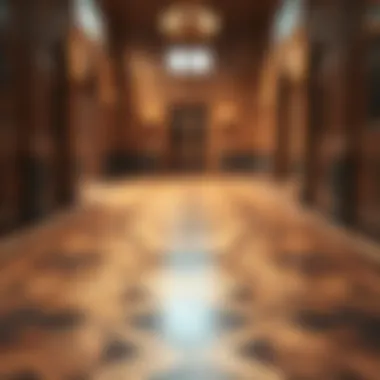
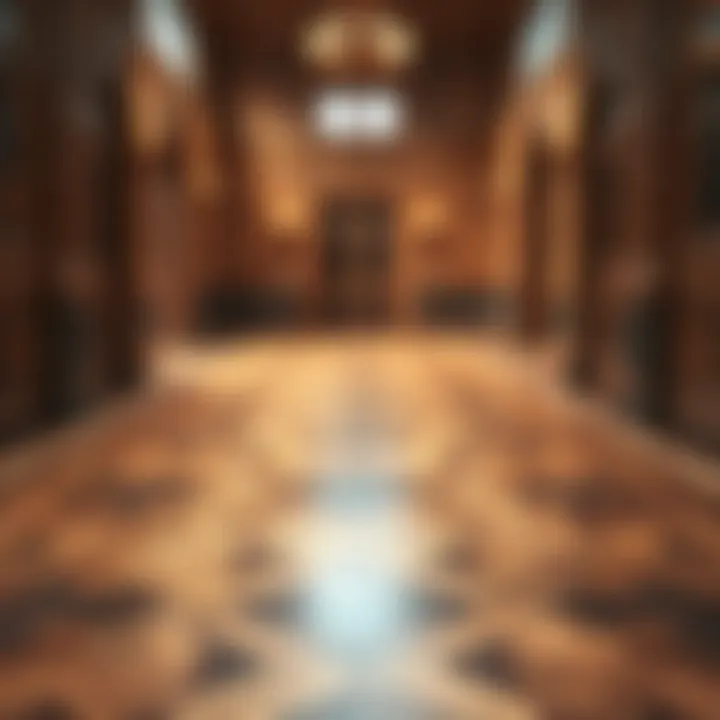
Intro
Wooden parquet flooring has made quite the name for itself in the realm of interior design, especially amidst the bustling neighborhoods of Dubai. Its intricate patterns and classic appeal transform spaces not merely into living areas but into genuine experiences. Yet, beneath its beauty lies a world filled with technical finesse, historical significance, and a vast array of choices. By getting a grip on understanding wooden parquet, whether from a realtor's perspective or as a homeowner seeking value, one can appreciate how this flooring doesn’t just serve, but excels.
One can argue that choosing the right flooring is akin to laying the foundation of style within a home. Investors, realtors, expatriates, and renters all find themselves navigating through options that may seem overwhelming at first. However, once the intricacies of wooden parquet are explored—its composition, installation methods, maintenance requirements, and the aesthetic benefits—it becomes clear why it stands out above other flooring materials.
In this exploration, we'll peel back the layers surrounding wooden parquet. From historic roots that trace back centuries to the modern-day significance in lavish properties, we will also touch on market trends, investment opportunities, and why wooden parquet flooring has become a substantial choice in real estate decisions today.
This deep dive serves not just as an academic exercise, but as a crucial resource for anyone involved in the dynamic market of Dubai, where aesthetics and functionality dance hand in hand. It's time to unravel the components that make wooden parquet a compelling asset in your property toolkit.
Prelude to Wooden Parquet
Wooden parquet is not just a flooring choice; it's an artistic expression that sits at the intersection of comfort and elegance. In today’s fast-paced real estate market, particularly in vibrant cities like Dubai, it’s essential to understand the intricacies of wooden parquet more than ever. This section lays the groundwork for exploring what wooden parquet truly entails, its historical roots, and what makes it a staple in modern designs.
Defining Wooden Parquet
At its core, wooden parquet refers to a classic flooring technique that utilizes small pieces of wood to create intricate patterns. These patterns are not merely about aesthetics; they inform the overall design language of a space. Parquet floors can vary in complexity, from simple squares to more elaborate herringbone or chevron layouts.
More than just a surface beneath our feet, parquet flooring provides warmth and a connection to nature, reflecting the beauty of wood itself. The variations in grain patterns, color, and texture can bring an added dimension to any room, contributing to a space's overall character. Therefore, when engaging clients or purchasing a home, knowledge of parquet’s qualities—including its versatility and timelessness—can significantly influence decisions.
Historical Background
Parquet flooring traces its history back to the 16th century in France, when craftsmen first began to use wood in a geometric design. Originally, this art form was a luxury confined to royal estates and lavish palaces. Imagine grand halls adorned with intricate woodwork, where every section bore witness to the grandiosity of its surroundings. This historical context emphasizes the status that parquet held as not only a floor covering, but also a symbol of wealth and sophistication.
As time went by, the use of wooden parquet expanded, reaching various parts of Europe and eventually the globe. The 20th century marked a significant turning point with the advent of engineered wood technology, making parquet more accessible to the masses. In contemporary settings, wooden parquet has adapted to fit modern aesthetics while still honoring its rich heritage. This duality of old and new keeps it relevant, appealing both to those with a sense of nostalgia and to design-forward thinkers.
“Parquet flooring is a timeless investment that pays dividends in style and functionality.”
Understanding this blend of history and definition not only enhances appreciation for wooden parquet but also informs practical decisions for current and prospective homeowners, realtors, and investors alike. In unpacking its facets, one can navigate from the precise patterns to broader market implications, all of which is explored further in the subsequent sections.
Types of Wooden Parquet
Understanding the Types of Wooden Parquet is crucial as it informs purchasing decisions, influences design choices, and affects the overall aesthetic and functionality of the flooring. Each type brings its own characteristics, benefits, and considerations that play a significant role in enhancing indoor spaces. This section will navigate through three main categories: Solid Wood Parquet, Engineered Wood Parquet, and Reclaimed Wood Parquet.
Solid Wood Parquet
Solid wood parquet is often seen as the gold standard when it comes to flooring. Made from single pieces of hardwood, this type offers strength and timelessness that many homeowners find appealing. Its natural charm is unmatched, presenting grains and color variations that imbue warmth into the space.
- Durability: These planks are designed to last, often for decades, making them a long-term investment.
- Refinishing Option: When wear and tear occurs, solid wood can be sanded and refinished multiple times, restoring its original beauty.
- Natural Insulation: Besides aesthetic values, being a natural material, it provides decent insulation, which can contribute to better energy efficiency in homes.
However, it’s worth noting that solid wood isn’t the best option for every environment. In high-humidity areas, wood can expand and contract, potentially leading to warping. Also, the cost is generally higher than other wood flooring types, which can be a factor for budget-conscious buyers.
Engineered Wood Parquet
Engineered wood parquet is a product designed to combine the beauty of hardwood with greater resilience to environmental challenges. Composed of multiple layers, with a top layer of real wood veneer, this type fuses aesthetics with function.
- Stability: Unlike solid wood, engineered wood is less affected by moisture and temperature fluctuations, making it suitable for basements and over radiant heat systems.
- Cost-Effective: Generally, engineered wood is more budget-friendly than solid wood, thus appealing to a wider audience including investors and renters looking for stylish flooring without breaking the bank.
- Ease of Installation: Many engineered wood products come with click-lock systems, making the DIY installation process simpler and quicker.
Nevertheless, it’s not entirely without drawbacks. When the top layer wears down, refinishing options are limited compared to solid wood, and while it looks and feels like real wood, it may not carry the same resale value for discerning buyers.
Reclaimed Wood Parquet
Reclaimed wood parquet brings a unique story to flooring. Sourced from previously used wood, it boasts history and character that cannot be replicated. Ideal for those seeking sustainable options, it is an ecological choice that reduces deforestation and promotes recycling.
- Unique Aesthetic: No two planks are alike, allowing homeowners to create bespoke looks with rustic charm and elegance.
- Sustainability: It’s an environmentally friendly choice that appeals to ecologically conscious consumers, which is becoming increasingly important in today’s market.
- Durability and Character: Reclaimed wood often comes from structures like barns or old factories, which tend to have tougher wood due to age.
On the flip side, finding quality reclaimed wood can be challenging, and the price can vary significantly based on rarity and demand. Furthermore, proper treatment is necessary to ensure there are no pests or contaminants lingering in the wood.
In summary, the choice of the parquet type plays a pivotal role in determining the overall look, feel, and functionality of a space. By understanding the nuances of each type, homeowners and investors can make informed decisions that suit their specific needs and preferences.
Design Considerations
When it comes to wooden parquet, design considerations play a significant role in determining not only the aesthetics but also the functionality of the space. The way parquet is arranged, its color and finish, and the overall design can dramatically influence the ambiance of a room. It's crucial for homeowners, designers, and investors alike to consider these factors thoroughly to enhance the value of the property and the satisfaction of its inhabitants.
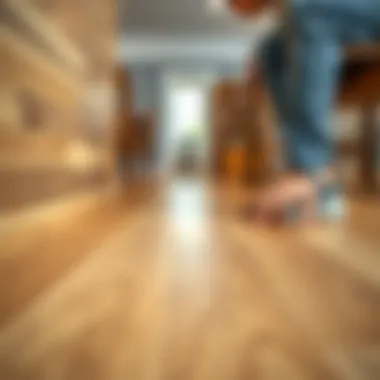
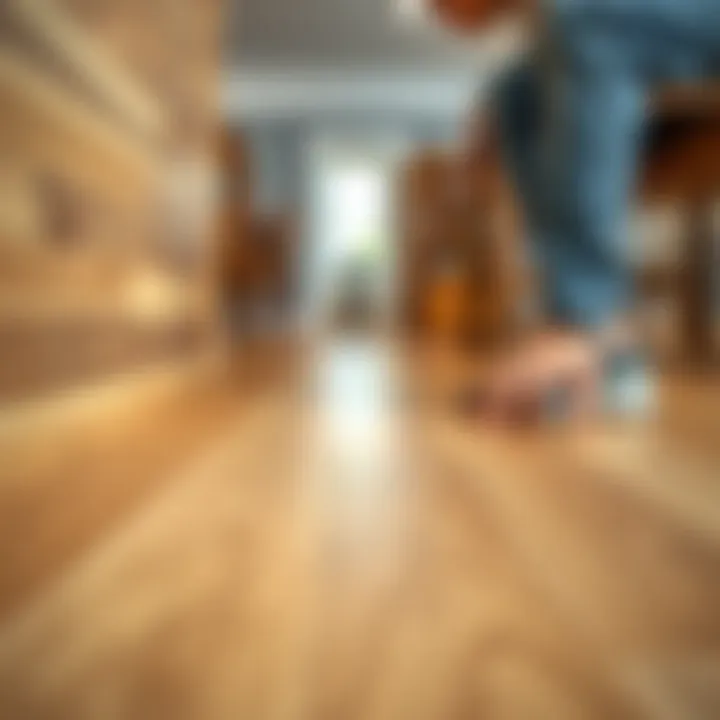
Patterns and Layouts
Different patterns and layouts can create unique visual effects in a space. Selecting the right arrangement can define the character of a room, making substantial impact on how spaces are perceived.
Chevron patterns
Chevron patterns are characterized by their V-shaped layout, which creates a dynamic and energetic feel within a space. This design choice is particularly beneficial due to its ability to appear both modern and classic simultaneously. The angular lines of chevron patterns guide the eye, creating a sense of movement throughout the room. However, one must consider that the intricate cutting required for chevron shapes can lead to higher installation costs.
Herringbone designs
Herringbone designs are quite similar to chevron, yet they provide a more subtle visual texture. The zig-zag pattern formed by rectangular pieces offers a timeless elegance that is hard to resist. This pattern can contribute to a cozy atmosphere, often associated with traditional settings, but it holds up well in contemporary designs as well. Though it's more forgiving in terms of installation than chevron, the unique cutting patterns may still pose challenges.
Square and rectangular arrangements
On the simpler side of the spectrum, square and rectangular arrangements offer a clean, structured appearance. These layouts are favored for their straightforwardness and versatility, making them a highly popular option among homeowners and designers alike. They can complement various interior styles, from minimalistic to eclectic interiors. However, the simplicity can sometimes lack the character found in more intricate designs, and may not create the same dramatic impact.
Color and Finish Choices
Color and finish are pivotal elements in wooden parquet design. The decisions made in this area can dramatically alter the mood of the room and affect other design elements.
Natural vs. stained finishes
Natural finishes bring out the raw beauty of the wood, allowing its unique grain and texture to shine through. This choice often emphasizes a rustic or organic feel that connects with nature. On the flip side, stained finishes offer an opportunity to customize colors that can enhance or complement a room's decor. Choosing between these options can depend on the overall aesthetic one desires. While natural finishes may need more frequent upkeep due to wear, stained finishes might hide scratches better, albeit at the cost of showing up imperfections in the wood grain.
Gloss vs. matte surfaces
The finish of the wood—glossy or matte—serves not only aesthetic purposes but functional as well. Gloss finishes tend to create a luminous surface, reflecting light and often making spaces feel larger. They are easier to clean, but can also amplify scratches and dust if not maintained properly. In contrast, matte surfaces provide a soft look and can hide imperfections well, making them a favored choice for high-traffic areas. However, matte finishes might require more effort when it comes to cleaning.
The design choices made for wooden parquet can significantly enhance not only the visual appeal but also the practical functionality of spaces, thereby optimizing value for property owners.
Installation Techniques
When it comes to wooden parquet flooring, installation techniques hold significant weight in determining the flooring's integrity and longevity. How well the parquet is installed can affect not just the aesthetic appeal but also its functionality. Each installation method has its own merits and downsides, which should be considered based on project specifics such as budget, subfloor condition, and desired look. Understanding these techniques is essential for making informed choices that align with one’s goals in design and practical use.
Pre-Installation Preparations
Before even laying down the parquet boards, prepping the area is crucial. This phase might seem mundane, but it sets the stage for success. First off, assessing the subfloor type—whether concrete, plywood, or another material—will dictate the installation method that can be used.
One important step is ensuring that the subfloor is clean, dry, and level. Any imperfections can lead to issues later on, like creaking noises or boards not locking together. Additionally, letting the wood acclimate to the environment is vital. This means leaving the boards in the room where they'll be installed for at least 48 hours. This practice reduces the risk of expansion or contraction after installation, ensuring that the flooring doesn’t buckle or gap unexpectedly.
Installation Methods
When diving into the actual installation, three key methods come to the forefront: nail-down, glue-down, and floating installations. Each has a unique identity, shaping its own niche in the flooring world.
Nail-down
The nail-down method holds a special place in the hearts of seasoned carpenters. This technique involves securing the wooden planks directly to the subfloor using nails, which creates a robust attachment to the surface beneath. One of its most notable characteristics is its lasting durability, but that’s not all.
- Benefits: The nail-down method is particularly popular because it can withstand heavy foot traffic, making it a solid choice for family homes or commercial settings. The locking mechanism reduces the chance of movement, helping to maintain a seamless look over time. Moreover, this method enhances sound insolation, providing a quieter environment.
- Considerations: However, it’s essential to note that this method requires a wooden subfloor and may not be compatible with all environmental conditions, especially areas with high moisture.
Glue-down
Moving to the glue-down method, it appeals to many due to its versatility. In this approach, a strong adhesive is applied to the subfloor before placing the parquet tiles or strips. What makes this method particularly powerful is its ability to adhere to many surfaces, including concrete.
- Benefits: One significant advantage is its capability to eliminate the risk of gapping, as the wood is bonded directly to the floor. This helps in maintaining a stable environment, reducing movement caused by temperature and humidity changes. It’s also an excellent choice for larger spaces where a seamless finish is desired.
- Considerations: On the flip side, glue-down installations can be labor-intensive, and the adhesives often require adequate drying time, which might extend the project timeline.
Floating installations
Lastly, there’s the floating installation method, which essentially allows the floor to "float" over the subfloor without being adhered or nailed down. These boards interlock on all sides, creating a tightly knit structure. One key characteristic is its ease of installation, attracting both professionals and handy DIY enthusiasts.
- Benefits: Floating installations simplify the process significantly since they can be put over almost any existing floor, saving time and cost on demolition. Plus, they’re less susceptible to buckling in fluctuating moisture environments since they aren’t fixed to the subfloor. It can be a great fit especially for renters who need a removable solution.
- Considerations: However, it’s vital to understand that floating floors might not provide the same high degree of sound insulation as other methods, which might be a factor for larger homes or apartments.
In the grand scheme of things, understanding how these installation techniques function creates a foundation for a more informed and higher-quality finished product. Whether you're a homeowner, investor, or realtor, knowing this can optimize any flooring project.
Maintenance of Wooden Parquet
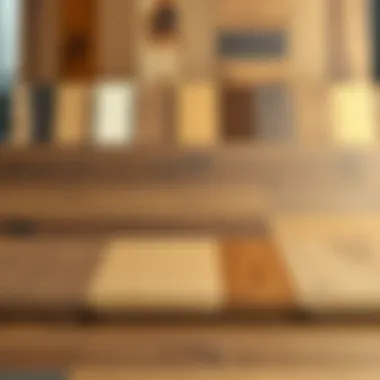
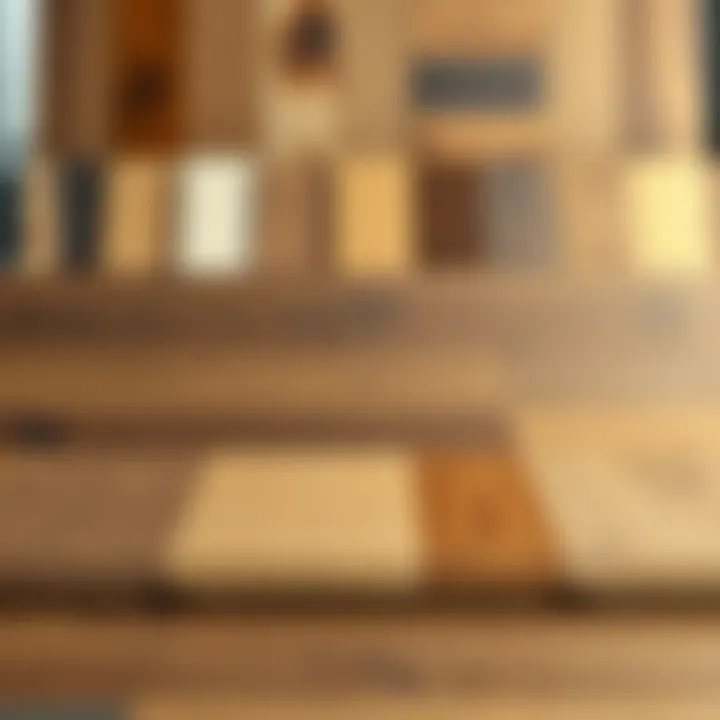
Maintaining wooden parquet flooring is crucial not just for keeping it looking pristine but also for prolonging its lifespan. A well-cared-for parquet floor can enhance the aesthetic appeal of a room while also serving as a practical solution that stands up to daily wear and tear. With various types of wood and finishes available, understanding the nuances of maintenance becomes essential for homeowners, real estate investors, and renters alike.
Regular Cleaning Practices
Keeping a wooden parquet floor clean is paramount to its durability. The first step is to vacuum regularly. Brooms can be handy, but vacuums equipped with soft bristles can trap dirt and debris more effectively and keep the wood protected. Occasionally mopping with a damp, not soaking, mop using a mild cleaner specifically designed for wood surfaces can remove stubborn stains.
Avoid harsh chemicals—these can strip the finish and degrade the wood. A simple mix of warm water and a few drops of biodegradable soap works wonders. Drying the floor promptly is also key to preventing any moisture damage.
Refinishing Techniques
Over time, even the most careful maintenance may require refinishing to restore the original luster. This process involves sanding down the surface to remove scratches and dingy areas. A coat of high-quality finish, either oil-based or water-based, is then applied. It’s not just a cosmetic fix—refinishing helps in preserving the structural integrity of the wood by creating a protective layer against moisture and wear.
In most cases, refinishing is recommended every few years, depending on foot traffic. For high-traffic areas, consider professional refinishing to ensure the job is done right, although many DIY enthusiast also approach this successfully with proper tools and techniques.
Preventing Damage
Sunlight exposure
Direct sunlight can wreak havoc on wooden parquet floors, causing them to fade and warp over time. This gradual damage can alter the floor’s natural color and finish. Using window treatments such as blinds or heavy drapes can minimize exposure. Another option includes applying UV-filtering films on windows, which allows sunlight while protecting the flooring.
Considering rugs in sun-drenched areas can also diffuse light and protect against discoloration. A noteworthy consideration is that while sunlight might bring warmth and brightness to spaces, its unfiltered presence can turn a masterpiece floor into a pale shadow of its former self.
Moisture control
Maintaining stable humidity levels is vital for wooden parquet. High moisture can lead to expansion and buckling, while too little can cause cracking. Place a dehumidifier or invest in a humidifier where necessary to regulate the environment. Using matts in entryways and wet areas, like kitchens and bathrooms, can be crucial in keeping excess moisture at bay. The essence of moisture control lies in creating a balanced atmosphere that keeps your parquet floors looking fabulous for years to come.
Preventive measures
Several preventive measures can be taken to mitigate wear and tear on parquet flooring. Using furniture coasters can prevent scratches from heavy items being dragged across the floor. Regular checks for loose boards or areas needing adjustment will help in catching problems early.
Moreover, it’s wise to avoid wearing shoes with hard soles, such as stilettos or heavy boots, inside your home—this can significantly reduce the potential for nicks and dents. A proactive approach here pays off, making maintenance considerably easier down the road.
In summary, regular cleaning, refinishing, and preventative strategies can work in harmony to ensure your wooden parquet flooring remains a beautiful and durable element in your home.
Advantages of Wooden Parquet
Wooden parquet flooring has carved out a significant niche in the realms of both aesthetics and functionality. Whether you are an investor, a realtor, or simply a homeowner in the market for flooring options, understanding the advantages of wooden parquet can help you make informed decisions. The topic is pertinent not just for its eye-catching appeal, but also for the structural and environmental benefits that it encompasses.
Aesthetic Appeal
One of the most enthralling aspects of wooden parquet is its striking aesthetic appeal. Picture walking into a room adorned with elegantly laid wooden patterns that draw the eyes and elevate the overall ambiance. From chevron to herringbone designs, there’s an unmatched elegance to patterns created from various types of wood. The natural grains and hues of wood also offer a warmth that few flooring materials can replicate.
- Versatility: The wide array of colors and finishes allows homeowners to tailor their choices based on the existing interior design. Whether it’s a rustic ambience with oak or a more modern touch with dark walnut, wooden parquet adapts beautifully to different styles.
- Timeless Quality: Unlike trendy tile or synthetic options, wooden parquet has a timeless quality that withstands decades and doesn't go out of style. It remains a solid investment for properties, adding an inherent charm that many buyers find attractive.
Durability and Longevity
When it comes to flooring investments, durability and longevity are non-negotiable. Wooden parquet excels in both respects. Though wood is often perceived as delicate, many modern types of parquet are engineered to withstand heavy foot traffic and the rigors of daily life.
- Resilience: Solid wood parquet, for instance, is made from high-density materials that can last for generations if properly maintained. Regular refinishing can help restore its beauty and prolong its life.
- Cost-Effectiveness: While the initial purchase might pinch the pocket, the longevity and minimal maintenance requirements mean fewer replacements over time. In the long run, wooden parquet often represents a more prudent investment compared to cheaper, less durable flooring alternatives.
Environmental Considerations
Sustainability is a growing concern in today’s world, and wooden parquet can align well with eco-friendly practices when sourced responsibly. Consumers increasingly lean towards materials that not only enhance their living spaces but do so while being conscious of their ecological footprint.
- Renewable Resource: When harvested from sustainable forests, wood is a renewable resource. Many manufacturers adhere to certifications such as FSC (Forest Stewardship Council), ensuring that the wood was sourced in a manner that supports forest conservation.
- Low Environmental Impact: Wood produces far less carbon dioxide during manufacturing than synthetic materials. Wooden parquet doesn’t emit toxic chemicals, creating a healthier living environment for homeowners. Choosing wood can ultimately contribute to a greater push towards sustainability.
"Investing in wooden parquet not only uplifts the aesthetic of your living space but also adds value through its durability and environmental friendliness."
Challenges Related to Wooden Parquet
Understanding the challenges related to wooden parquet flooring is essential for anyone considering its implementation in their space. While wooden parquet offers considerable aesthetic and functional advantages, it is not without its hurdles that investors, realtors, and homeowners must navigate. The topics of cost and climate sensitivity stand out as two primary elements that influence decisions around wooden parquet flooring and can significantly impact the user experience.
Cost Considerations
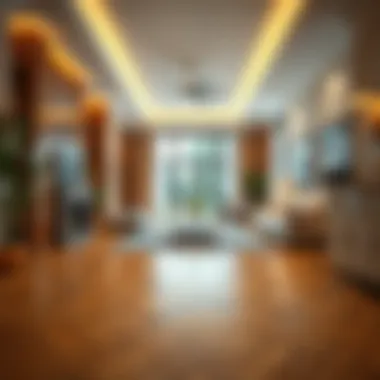
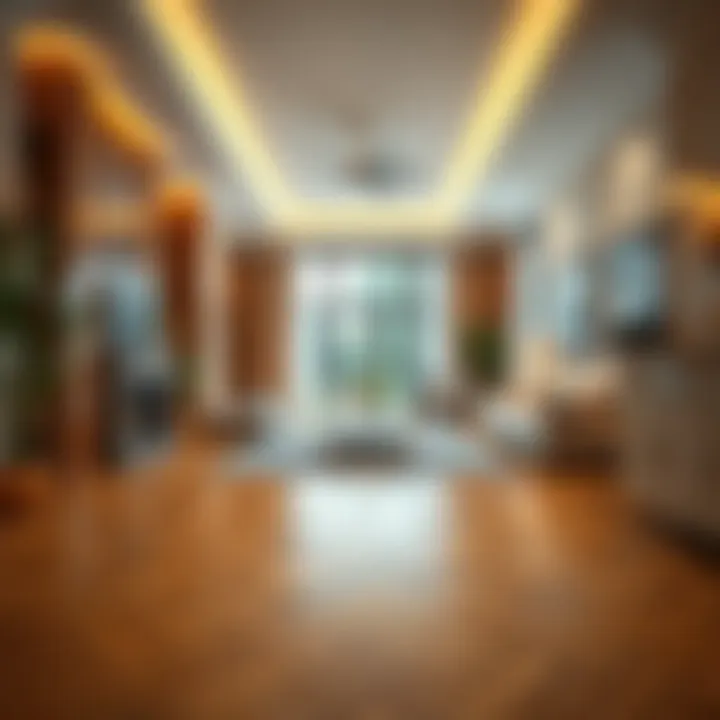
One of the most significant aspects to ponder when contemplating wooden parquet is the financial investment involved. Prices can swing wide, depending on several factors, including the type of wood, quality, and design complexity. For instance, solid wood parquet often carries a heftier price tag compared to engineered varieties due to its higher material costs and labor-intensive installation methods.
- High-Quality Materials: Using premium varieties of wood, like oak or cherry, can drive costs up. This is particularly true for unique or rare grain patterns that add character but come with a price.
- Installation Expenses: The cost of installation can't be brushed aside either. Hiring skilled labor for intricate designs like herringbone may cause the expenditure to leap. DIY installations may save some bucks, but they require a certain level of skill and precision.
- Long-Term Investment: While the upfront costs may seem daunting, wooden parquet often raises property values. For homeowners and investors looking to sell later, this can prove quite beneficial.
In summary, budgeting correctly for wooden parquet flooring involves understanding all possible costs, keeping in mind both initial expenses and long-term returns.
Sensitivity to Climate
The nature of wooden parquet makes it particularly sensitive to climate fluctuations. Wood, by its very nature, is hygroscopic, which means it absorbs moisture from the air. Here’s what that means for your parquet flooring:
- Expansion and Contraction: During periods of high humidity, wooden parquet can swell. Conversely, in dry conditions, it may shrink. This can lead to gaps between the tiles and potentially weaken the installation over time.
- Temperature Variability: In regions with significant temperature changes, homeowners need to consider how their laying environment influences the wood. Fluctuating temperature can warp the flooring material, affecting both aesthetics and functionality.
- Preventative Measures: To safeguard against these issues, climate control systems and humidity regulators can be installed. Specialized underlays can also help mitigate the impact of moisture and temperature shifts.
It's crucial for anyone venturing into wooden parquet to be mindful of these challenges, as proper management can lead to a satisfying and long-lasting installation.
“Being aware of potential pitfalls is the first step to ensuring your investment pays off in the long run.”
By understanding these cost considerations and climate sensitivities, homeowners, investors, and renters can make informed decisions about wooden parquet that align with their needs and preferences.
Trends in Wooden Parquet
Keeping an eye on trends in wooden parquet is crucial for several reasons. As design preferences evolve, so too do the styles and materials that homeowners and property developers embrace. Understanding these trends helps potential investors and homeowners make informed decisions about their flooring choices. Moreover, local market trends can influence property values in neighborhoods like Dubai, where aesthetics and function play a significant role in living spaces.
Current Market Trends
As of late, several key trends have emerged within the wooden parquet flooring market:
- Sustainable Sourcing: There’s a clear movement towards using timber sourced from sustainable forests. Buyers today are not just concerned about the look, but also about the environmental impact. Thus, reclaimed wood and responsibly harvested options are increasingly popular.
- Mix of Installations: An interesting trend is the integration of different wood species within a single flooring layout. This mixture can offer a unique, custom look, allowing homeowners to express their individual style. Some opt for contrast between a dark and light wood, creating a striking visual appeal.
- Vintage Aesthetics: The allure of vintage styles has resurged, with wear patterns and distressed finishes gaining traction. These designs evoke nostalgia while offering a contemporary twist, making spaces feel inviting.
- Minimalist Patterns: As homes become streamlined in design, parquet patterns have begun trending towards simpler layouts. Straight cuts and less intricate arrangements resonate well with the minimalist philosophy many modern homeowners are adopting.
Future Predictions
Peering into the future, several predictions can be drawn regarding wooden parquet trends:
- Smart Flooring Solutions: As technology becomes more integrated into our lives, flooring solutions that incorporate smart features may enter the limelight. Imagine wooden parquet that can help monitor humidity levels or even adjust temperature!
- Health-Conscious Materials: With a growing awareness of indoor air quality, materials that promote healthier living environments could become more prevalent. Expect to see finishes and treatments that are less toxic and free from harmful chemicals.
- Adaptability to Aesthetic Trends: In the coming years, we might witness even more fluidity between different flooring types, where parquet can adjust to different home styles. This could involve finishes that easily change from a rustic to a modern look without needing to replace the entire flooring.
The evolution of wooden parquet continues to be shaped by various factors, including consumer preferences, environmental impacts, and advancements in technology, making it an exciting field to watch.
Cultural Implications
The choice of flooring is more than just a practical consideration; it's deeply rooted in the cultural context of a region. Wooden parquet, with its storied past and aesthetic versatility, carries significant cultural implications that resonate with homeowners, interior designers, and real estate investors alike. In different parts of the world, parquet is not only seen as a style statement but also reflects social status, historical connections, and craftsmanship traditions. Understanding these cultural dimensions adds a layer of appreciation for wooden parquet that goes beyond its surface appeal.
Regional Preferences
In various regions, preferences for wooden parquet can differ significantly due to factors like climate, historical context, and available materials. For instance, in Northern Europe, the rich hues of oak or beech are favored, reflecting a local affinity for natural materials and adherence to traditional craftsmanship. In contrast, markets like Dubai lean towards exotic wood species such as teak or mahogany, valued for their luxurious finish and durability in warmer climates.
- Cultural Heritage: In places like France, parquet has historical significance, where it was first introduced in the grand estates of the aristocracy during the 17th century. Its intricate designs signify a sense of opulence, still appealing to modern homeowners who aspire to recreate that aesthetic vibe in contemporary interiors.
- Adaptation to Local Norms: On the contrary, regions with a tropical climate may emphasize lighter-colored woods that not only help in cooling the interior but also complement the vibrant surroundings. This practical adaptation highlights how cultures shape flooring choices based not just on beauty but on environmental necessities.
- Craftsmanship Appreciation: In many Asian cultures, there is a renewed interest in handcrafted wooden parquet, which embraces imperfections and variations in the wood. This approach emphasizes authenticity and individual expression, contrasting with the industrially produced options that dominate Western markets.
The choice of parquet reflects deeper cultural layers and economic conditions, making it vital for investors and homeowners alike to understand these preferences to make informed decisions.
Integration in Modern Design
As interior design evolves, so too do the ways in which wooden parquet is integrated into modern spaces. No longer restricted to traditional homes, parquet floors are finding their place in contemporary apartments, office spaces, and public areas. This versatility signifies not just aesthetic trends but also a blend of functionality with artistic expression.
- Sustainability Trends: In an era that values sustainability, many designers are opting for eco-friendly wooden parquet that resonates with consumers’ desire for responsible living. Reclaimed wood parquet, for instance, offers a unique blend of history and environment-friendly practices. The variations in texture and color often tell a story, enhancing the narrative of the space.
- Open Floor Concepts: In modern design schemes, particularly in urban environments, flooring choices play a crucial role in connecting different areas of a home or commercial space. Parquet's ability to meld various styles through patterns like herringbone or chevron creates visual continuity, allowing for a cohesive look that enhances the use of open spaces.
- Color and Finish Variety: The expansion into colored and textured finishes provides an opportunity for creative expression. From minimalist Scandinavian designs to bold, rich tones seen in modern bohemian aesthetics, the adaptability of wooden parquet allows it to complement various design philosophies.
"Wooden parquet reflects a tapestry of influences, mirroring both tradition and modernity in its manifestation."
As such, understanding the cultural implications of wooden parquet is essential for those engaged in the real estate market. It ensures that selections align not only with functional needs but also represent the intricate dance of cultural identity and modern design principles.
Epilogue
As we draw the curtains on this detailed exploration of wooden parquet, it's worth emphasizing just how significant this flooring choice can be for various stakeholders in the property market. For investors and realtors, understanding wooden parquet isn't just about knowing its aesthetic value; it boils down to grasping what differentiates assets in an ever-competitive real estate landscape. This material can dramatically enhance both the appeal and value of a property, particularly in vibrant markets like Dubai, where the integration of luxury and tradition often dictates buyer preferences.
Homeowners and expatriates should recognize that wooden parquet is not simply a flooring option but a lifestyle choice. With its historical richness and varied styles, it enables one to express individuality while ensuring quality craftsmanship underfoot. Furthermore, renters can find solace knowing that investing in spaces adorned with parquet may yield better living experiences and potential cost savings during their tenancy.
In our discussion, we've touched on crucial elements like installation methods, maintenance routines, and the challenges and benefits associated with this material.
Key Considerations:
- Aesthetic Versatility: Wooden parquet complements various interior design styles, from modern minimalism to classic elegance.
- Long-term Investment: With proper care, parquet floors can last for decades, making them a worthwhile expenditure.
- Environmental Responsibility: Opting for sustainable wood sources contributes to eco-friendly practices.
Ultimately, the choice to incorporate wooden parquet is intertwined with personal taste and informed decision-making. From installation techniques to maintenance insights, the knowledge gained through this guide empowers readers to make choices that not only resonate with their design aspirations but also connect deeper with a piece of flooring history.



